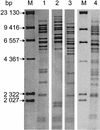Molecular typing of Clostridium perfringens from a food-borne disease outbreak in a nursing home: ribotyping versus pulsed-field gel electrophoresis
- PMID: 12574310
- PMCID: PMC149667
- DOI: 10.1128/JCM.41.2.892-895.2003
Molecular typing of Clostridium perfringens from a food-borne disease outbreak in a nursing home: ribotyping versus pulsed-field gel electrophoresis
Abstract
In 1998, 21 inhabitants of a German nursing home fell ill with acute gastroenteritis after consumption of minced beef heart (P. Graf and L. Bader, Epidemiol. Bull. 41:327-329, 2000). Two residents died during hospital treatment. Seventeen Clostridium perfringens strains were collected from two different dishes and from patients' stool samples and autopsy materials. A majority of these isolates was not typeable by restriction fragment length polymorphism-pulsed-field gel electrophoresis (PFGE). Subsequent ribotyping of C. perfringens distinguished four different groups. The same ribopattern was detected in a minced beef heart dish, in autopsy material from the two deceased patients, and additionally in stool samples from six further residents who had fallen ill with diarrhea. Three further ribopatterns from food and autopsy materials could be differentiated. As chromosomal macrorestriction with subsequent PFGE is generally regarded more useful than ribotyping for molecular strain analysis, four selected isolates were lysed in parallel with a standard protocol and two nucleases inhibiting modifications. Neither of these methods could differentiate all of the isolates. These results suggest that PFGE with the current standard protocols is not able to characterize all C. perfringens isolates from food-borne disease investigations and that ribotyping is still a helpful method for molecular identification of clonal relationships.
Figures


Similar articles
-
Molecular subtyping of Clostridium perfringens by pulsed-field gel electrophoresis to facilitate food-borne-disease outbreak investigations.J Clin Microbiol. 1999 Jul;37(7):2209-14. doi: 10.1128/JCM.37.7.2209-2214.1999. J Clin Microbiol. 1999. PMID: 10364587 Free PMC article.
-
Ribotyping for strain characterization of Clostridium perfringens isolates from food poisoning cases and outbreaks.Appl Environ Microbiol. 1997 Oct;63(10):3992-4. doi: 10.1128/aem.63.10.3992-3994.1997. Appl Environ Microbiol. 1997. PMID: 9327563 Free PMC article.
-
Molecular methods for the analysis of Clostridium perfringens relevant to food hygiene.FEMS Immunol Med Microbiol. 1999 Jul;24(3):281-6. doi: 10.1111/j.1574-695X.1999.tb01295.x. FEMS Immunol Med Microbiol. 1999. PMID: 10397312
-
Genomic diversity of necrotic enteritis-associated strains of Clostridium perfringens: a review.Avian Pathol. 2016 Jun;45(3):302-7. doi: 10.1080/03079457.2016.1153799. Avian Pathol. 2016. PMID: 26949841 Review.
-
[Clostridium perfringens].Nihon Rinsho. 2012 Aug;70(8):1357-61. Nihon Rinsho. 2012. PMID: 22894072 Review. Japanese.
Cited by
-
An epidemiological review of gastrointestinal outbreaks associated with Clostridium perfringens, North East of England, 2012-2014.Epidemiol Infect. 2016 May;144(7):1386-93. doi: 10.1017/S0950268815002824. Epub 2015 Nov 16. Epidemiol Infect. 2016. PMID: 26567801 Free PMC article.
-
Genetic diversity of Clostridium perfringens type A isolates from animals, food poisoning outbreaks and sludge.BMC Microbiol. 2006 May 31;6:47. doi: 10.1186/1471-2180-6-47. BMC Microbiol. 2006. PMID: 16737528 Free PMC article.
-
Molecular subtyping of poultry-associated type A Clostridium perfringens isolates by repetitive-element PCR.J Clin Microbiol. 2006 Mar;44(3):1065-73. doi: 10.1128/JCM.44.3.1065-1073.2006. J Clin Microbiol. 2006. PMID: 16517895 Free PMC article.
-
Pulsotype Diversity of Clostridium botulinum Strains Containing Serotypes A and/or B Genes.Foodborne Pathog Dis. 2017 Sep;14(9):494-501. doi: 10.1089/fpd.2017.2280. Epub 2017 Jul 10. Foodborne Pathog Dis. 2017. PMID: 28692343 Free PMC article.
-
Pulsed-field gel electrophoresis of enterotoxic Clostridium perfringens type A isolates recovered from humans and animals in Kolkata, India.Int J Vet Sci Med. 2017 Dec 15;6(1):123-126. doi: 10.1016/j.ijvsm.2017.11.002. eCollection 2018 Jun. Int J Vet Sci Med. 2017. PMID: 30255089 Free PMC article.
References
-
- Björkroth, J., and H. Korkeala. 1996. rRNA gene restriction patterns as a characterization tool for Lactobacillus sake strains producing ropy slime. Int. J. Food Microbiol. 30:293-302. - PubMed
-
- Eisgruber, H., M. Wiedmann, and A. Stolle. 1995. Use of plasmid profiling as a typing method for epidemiologically related Clostridium perfringens isolates from food poisoning cases and outbreaks. Lett. Appl. Microbiol. 20:290-294. - PubMed
-
- Forsblom, B., A. Palmu, P. Hirvonen, and H. Jousimiessomer. 1995. Ribotyping of Clostridum perfringens. Clin. Infect. Dis. 20(Suppl. 2):323-324. - PubMed
MeSH terms
Substances
LinkOut - more resources
Full Text Sources
Medical
Research Materials

